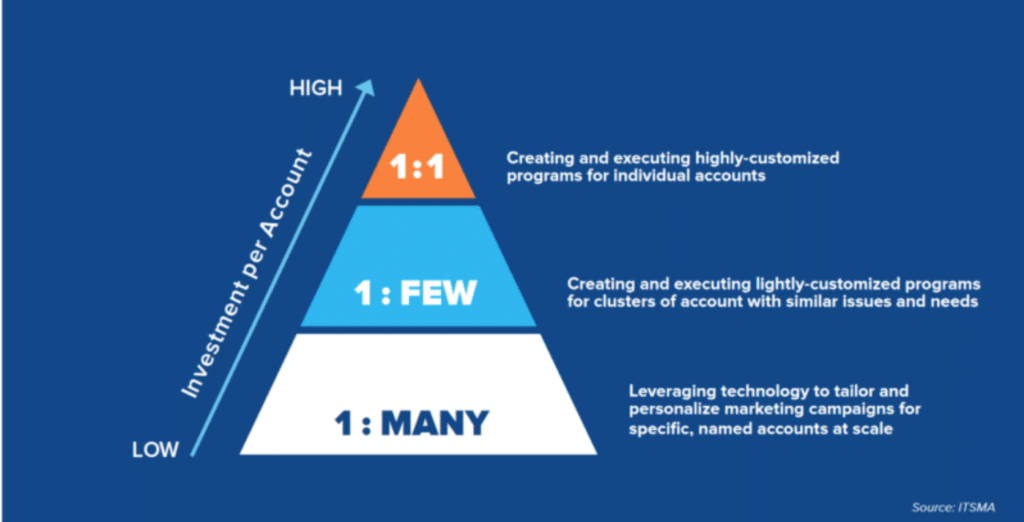Account-based marketing segmentation is a powerful tool for boosting the ROI of your account-based marketing strategy. Foundry’s 2023 ABM Benchmark Study indicates that one-third of marketers estimate their average ABM contract value to be over $100,000.
Achieving a similar ROI from your ABM initiatives is possible, but it takes the right approach. This guide will examine account segmentation and its role in targeting key accounts. It will also show you how to use this approach to optimize your content marketing campaigns and sales outreach—two key aspects of successful ABM.
What is Account-Based Marketing Segmentation
Account-based marketing segmentation divides your target account list into groups (segments) that share similar challenges, goals, and pain points. This helps B2B marketing teams prioritize accounts based on their alignment with ideal customer profiles (ICP), potential value, and readiness to buy.
A three-tiered approach is used to segment target accounts:
- One to Many (Low Priority): This tier includes a larger group of accounts suited for generalized marketing efforts, typically accounts with lower potential ROI.
- One to Few (Medium Priority): This tier focuses on a smaller subset of accounts, allowing for more personalized marketing strategies that meet each group's specific needs.
- One-to-One (High-Priority): This tier prioritizes individualized customer experiences and hyper-targeted digital marketing campaigns for high-value accounts.

Why Segment Your Target Account List?
Ever had that eerie moment when you spot an ad for something you need right when you need it most? That's the magic of customer segmentation at work. By splitting your target audience into similar groups, you can tailor your content and offers to their exact needs.
Account segmentation supports the creation of hyper-relevant marketing campaigns, in addition to:
- Enhanced ROI: Segmentation boosts marketing returns by using a data-driven approach to create content and personalized experiences that target accounts most likely to convert.
- Competitive Advantage: Understanding audience segments better than competitors enhances marketing efforts and positions your brand ahead in the market.
- Optimized Resource Allocation: Segmentation dials your focus on accounts most likely to convert, avoiding wasted time and resources on less receptive audiences.
- Improved Personalization & Loyalty: Segmenting your audience improves ABM personalization by streamlining your approach to targeting specific account groups, boosting engagement and long-term loyalty.
With a nuanced understanding of individual accounts and decision-makers, your ABM campaigns become more impactful, effective, and efficient. Segmentation ensures your messaging is relevant and hits the mark.
A 3-Step Approach to Account-Based Marketing Segmentation
A key ABM best practice is to segment your target account list early into your ABM program. Ranking accounts based on priority and potential ROI effectively guides your ABM content marketing strategy and improves resource and budget allocation.
With those goals in mind, let’s jump into the step-by-step approach to segmenting your account-based marketing program.
Step 1: Split Your Total Addressable Market into Target Market Segments
The first step of segmentation is to break out the accounts in your total addressable market that align with your ICP. Your total addressable market (TAM) refers to the total revenue opportunity available within a specific market segment or industry.
Create a separate list for each market segment and consider the customer journey. Accounts deemed “not ready to buy” will be saved for further nurturing and brand awareness campaigns. These accounts suit a one-to-many ABM content approach with little personalization.
Best Tools to Segment Your TAM:
- Customer Relationship Management (CRM) Software: Use platforms like Salesforce or HubSpot to dive into your customer data and begin segmenting based on criteria such as demographics, company size, and behavior and interactions.
- Market Research Tools: Tools like Statista, Adobe Marketo Engage, and SurveyMonkey are great market intelligence software for providing access to market research data, such as surveys, analytics, and other insights on market trends and customer preferences.
Step 2: Split Your Target Market Segments into Target Accounts
From the market segments you created in step one, start a new list just for the accounts that fit your ICP and are nearing the decision stage of the buyer’s journey.
These are accounts you’ll nurture and pursue through personalized content marketing campaigns, with the goal of moving them into your sales funnel. These accounts fit the one-to-few ABM content strategy, which prioritizes personalization and relationship-building with target accounts.
Best Tools to Define Target Accounts:
- Predictive Analytics Software: ABM software such as 6Sense or Leadspace uses AI and machine learning to identify high-value accounts based on historical data, firmographics, and buying signals.
- Intent Data Platforms: ZoomInfo Sales and LinkedIn Sales Navigator help you analyze metrics like website visits, content consumption, and engagement with specific topics to identify accounts showing active buying intent.
Step 3: Create Priority Account Segments from Your Target Accounts
Finally, it’s time to pinpoint the highest priority accounts for your ABM strategy. These accounts best suit a one-to-one ABM content approach with hyper-targeted messaging.
Marketing efforts for these accounts demand the most resources, time,, and budget, given their high potential for conversion and large deal size. Success requires dedicated marketing teams, sales reps, and tailored campaigns. For that reason, opt for accounts you already have a relationship with when building your high-priority segment.
To ensure that accounts on this list are ready to buy, use marketing automation tools and your existing CRM data to support your selections.
Best Tools to Segment High-Value Accounts:
- Data Enrichment Tools: Tools like Cognism and Clearbit enrich existing CRM and client data with additional details on companies (technology stack, key stakeholders, new hires, etc.) to improve account targeting.
- Lead Scoring Tools: Platforms such as MadKudu, Brevo, or Drift offer account scoring capabilities to help you rank and prioritize target accounts based on factors such as fit, intent, and engagement.
Implementing a strategic approach to ABM segmentation can yield significant benefits. Our piece on 30 ABM statistics that prove its value is a great place to start if you are in doubt.
4 Account-Based Marketing Segmentation Best Practices
Effective segmentation is at the heart of successful account-based marketing strategies. Let’s quickly explore four best practices for segmenting your target accounts, each designed to maximize the impact of your ABM tactics and drive stronger conversion rates.
Use Predictive Lead Scoring to Segment Your Account Lists
Predictive lead scoring uses AI and machine learning algorithms to predict customer behavior and buying intent. It evaluates factors such as firmographics, engagement history, and buying signals to assign a score to each account.
Update your lead scoring models regularly to reflect changing marketing conditions and customer preferences. Collaborate closely with your sales team to define lead-scoring criteria and distinguish between marketing-qualified leads (MQLs) and sales-qualified leads (SQLs).
Incorporating predictive lead scoring in your segmentation strategy improves your ability to allocate resources, maximize ROI, and drive success in your ABM initiatives.
Segment Only If Necessary
While segmentation can be valuable, it's important to assess whether it's truly necessary for your ABM strategy. Segmenting your target accounts requires significant time, resources, and data analysis.
Before tackling segmentation, consider whether your marketing goals and resources justify the effort. If limited resources and budget are a concern, a broader approach may be better suited.
Conduct a cost-benefit analysis to determine the potential impact of segmentation on your ABM outcomes. This prioritizes efficiency in your ABM strategy by segmenting only when it aligns with your specific business objectives.
Ensure Your Segments are Actionable for Your ABM Team
Collaborate closely with your sales team to define relevant, actionable segmentation criteria that are aligned with your overall strategy.
In LinkedIn’s webinar, The ABM Roadmap: 5 Steps to Success, Olivia Cain, Senior Content Manager for LinkedIn Marketing Solutions, emphasized a collaborative approach to defining accounts.
Creating actionable segments that align with your sales goals streamlines ABM efforts, improves collaboration, and drives stronger results.
Use the Right ABM Segmentation Tools
ABM segmentation requires a good deal of data analysis. Using the right tools improves efficiency when identifying, prioritizing, and segmenting target accounts.
Find the right ABM tool for your business by reading our in-depth review of the best account-based marketing software.
Look into predictive analytics software and intent data platforms to pinpoint high-value accounts based on historical data, firmographics, and buying signals. The good news is that multiple all-in-one ABM tools are available on the market.
Ready to Enhance Your ABM Strategy?
Account segmentation is a key driver of ABM's success. By dividing your target accounts based on shared challenges and goals, you can prioritize accounts primed for conversion, improve resource use, and maximize ROI.
Remember, collaboration with your sales team is essential, and consider investing in ABM software to support your entire strategy – from segmentation to sales outreach.
Good luck out there, and don’t forget to subscribe to The CMO newsletter to stay up-to-date on the latest digital marketing trends and insights.



